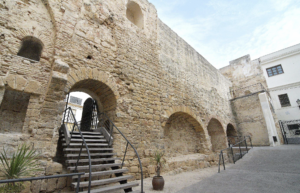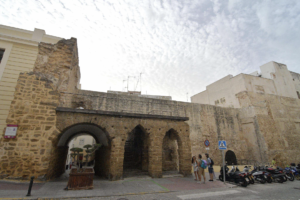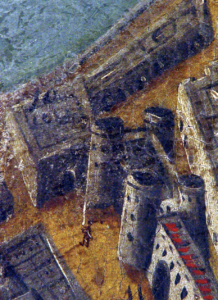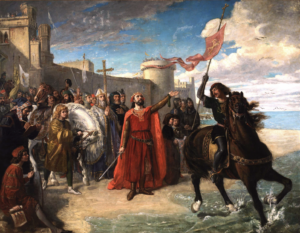
Medieval age
Military heritage
With the arrival of the Muslims in the 8th century, the urbanization of the city was restarted and a first wall was built that would later be reused with a Christian fortification.
Maritime heritage
Muslims and Christians were aware of the strategic importance of the port of Cádiz for the control of the Mediterranean and the passage through the Strait of Gibraltar.
Industrial heritage
During the Middle Ages, the port developed a naval industry and an incipient local trade in small shops on the outskirts of the Santa María suburb.

From Muslim occupation to Christian conquest

From the 4th century AD The city of Cádiz was framed in a clear deurbanization contextualized in a process of economic and social crisis.
From the end of the Antiquity age we can speak about a change in economic activity that turns towards a model of rural exploitation, bringing this as a consequence a movement of the population towards the interior zone and also causing numerous changes in what concerns to the road transportation and maritime network with the search for other points geographically better located than the city of Cádiz to give output to the products.
Although it is true that in these early moments of the Middle Ages the city itself suffered these characteristics, the situation changed throughout the historical period that oscillates between the 5th and 15th centuries AD, affecting in a new phase of urbanization that will lay the foundations of the subsequent urban growth.

It will not be until the arrival of the Muslims in the Iberian Peninsula in the year 711 that a new process of urbanization can be discussed again.
The Muslim conquest of the city of Cádiz, now renamed as Yazirat Qadis, reverberated in a new urban model that, as confirmed by the latest archaeological findings, followed the characteristic lines of urbanization of their culture, although with some peculiarities that will later be pointed out. The first indicators at the beginning of the formation process of the new city are provided by the written sources that speak of the existence of a small tower erected on the foundations of the old Roman theater, which gave it a certain elevation on the ground and whose function It would be the one of a watchtower. This tower, called the Al – Malab tower and translated as a theater tower, it should be understood as the starting point towards the formation of the new Hispanic – Muslim city of Yazirat Qadis.
The location of this tower and his subsequent fortification marked the urban planning of the Muslim fence around the current neighborhood of El Pópulo, an area chosen to be a strategic point to find here the remains of the ancient Roman theater that served as a foundation for the Saracen constructions as well as a higher height on the high level of the surrounding terrain and for his location with respect to the sea that provided control over the bay and the natural defense provided by the cliff facing south.
The existence of the Al-Malab tower is only known by the written sources because today no material evidence of this has been found although it is assumed that from his construction began to forge the Hispanic-Muslim fortification, according to the data contributed by archeology, would be placed chronologically in the 11th century AD coinciding with the period of Almoravid occupation in the Iberian Peninsula.

About the town of Cádiz in medieval Christian times we have more information thanks to recent research. As an example of this, we must have to talk about the monograph on the Castillo de la Villa that Rosario Fresnadillo made in 1989, where she proposes diverses hypotheses about his development from documentary studies and material surface evidence before the first archaeological interventions in the neighborhood of El Pópulo.
Fortunately, nowadays Cádiz has some important archaeological findings that have allowed us to provide new information with which to expand knowledge about the development of the fortress. And although it is true that the material evidence is quite moderate, it does seem to make clear the existence of a considerable space of occupation before the arrival of Christians.
In 1262 the Chris ans conquered the city of C diz led by Alfonso X “El Sabio” which brought with it the restoration of the Muslim fence. This fact suggests that the route of the Christian fortification currently conserved did not have to be far from the Hispanic-Muslim fence as there was a reuse of these exis ng structures to modify and expand the town according to their needs.

From this moment, the Christian village can be described in a quadrangular form that is revealed through the urban planning marked by the street and square of San Juan de Dios, Pelota street and the Cathedral square. A fortress that, like the first one, would be made up of three walls with three entrances or gates, the Arch of Los Blanco, open towards Land Front; the Arch of El Pópulo or Puerta del Mar, open to the sea; and the Arch of La Rosa, open to the suburb of Santiago since the 16th century.
As a second defensive bastion there would be the so-called Castle of La Villa, located at the top of the “monturrio” and of which only his founda ons remain under the current building of the municipal nursery. It is also worth noting the existence of the Albarrana Tower, that is, an extension of the wall of the land front that acted as a protection and surveillance.
Between the end of the 15th century and the beginning of the 16th the village ended up his designed totally, except for some palatial houses and other buildings that were annexed to the exterior of the wall facing the port, pointing up to the future splendor economic of the city and his rela onship with the sea.
Evolution of the city of Cádiz through its military, maritime and industrial heritage (MMI)
